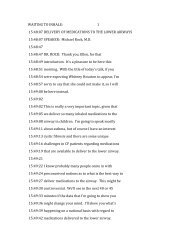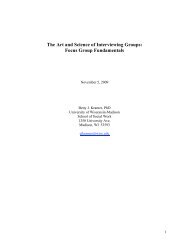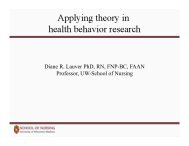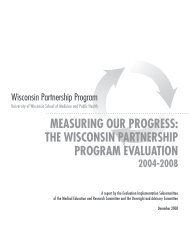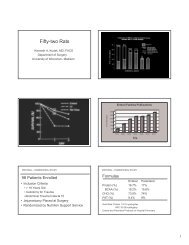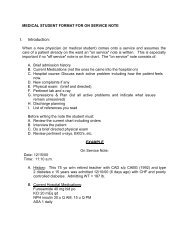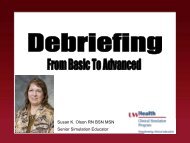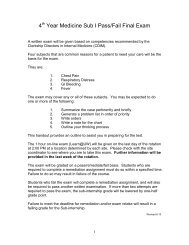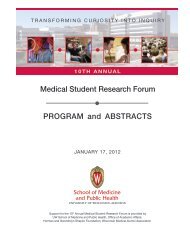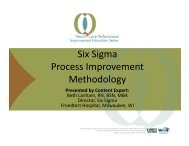COMMENTARY<strong>Exploring</strong> <strong>the</strong> <strong>Harmful</strong> <strong>Effects</strong> <strong>of</strong> <strong>Health</strong> <strong>Care</strong>Charles M. Kilo, MD, MPHEric B. Larson, MD, MPHWHILE VARIOUS FORMS OF HARM RESULTINGfrom health care are well known, <strong>the</strong> fullnature <strong>of</strong> such harm and <strong>the</strong> magnitude <strong>of</strong>health care’s aggregate adverse heal<strong>the</strong>ffects deserve more exploration. On balance, <strong>the</strong> dataremain imprecise, and <strong>the</strong> benefits that US health carecurrently deliver may not outweigh <strong>the</strong> aggregate healthharm it imparts. In this Commentary, we discuss potentialharms from health care, suggest a taxonomy forhealth care harm, and suggest that investigators startaddressing this issue.This concern is raised with great respect for health carepr<strong>of</strong>essionals. To be sure, ill intent is rare, and many healthservices are effective. None<strong>the</strong>less, it is time to address <strong>the</strong>possibility <strong>of</strong> net health harm by elucidating more fully aggregatehealth benefits and harms <strong>of</strong> current health care. Thisinformation should help clinicians, health care leaders, policyexperts, and politicians improve health outcomes by allowingmore explicit consideration <strong>of</strong> <strong>the</strong> trade-<strong>of</strong>fs involvedin health interventions and expenditures, and help guidehealth care reform efforts.Unlike health, health care is not an unalloyed good. Fisher 1estimates that perhaps one-third <strong>of</strong> medical spending is for“services that don’t appear to improve health or <strong>the</strong> quality<strong>of</strong> care—and may make things worse.” Although health carecontributes to health through disease prevention and treatment,<strong>the</strong> aggregate effect on health may be smaller thangenerally assumed.Determinants <strong>of</strong> well-being transcend health care. Theyinclude <strong>the</strong> complex interaction over time between genetics,social circumstances, education, income, housing, publicsafety, job satisfaction, behavioral patterns, and environmentalquality, in addition to access to appropriate healthcare services. 2 For example, since health care contributesonly about 10% toward reducing premature death, even aperfectly designed delivery system would prevent only a modestproportion <strong>of</strong> premature death. 3A Taxonomy <strong>of</strong> <strong>Health</strong> HarmHarm may occur as a direct or indirect consequence <strong>of</strong> healthcare. Direct harm includes adverse physical and emotionaleffects, generally to individuals, as a by-product <strong>of</strong> healthcare delivery. Indirect harm is a collateral effect on individualsand communities not directly involved in care. Indirectharm is closely associated with excess health care costs,which may induce harm by competing with o<strong>the</strong>r healthproducingservices.Direct HarmPhysical Harm. Physical harm is a by-product <strong>of</strong> routine careprocesses. Some aspects <strong>of</strong> physical harm (eg, adverse drugeffects and medical errors) are better known than o<strong>the</strong>rs(eg, untoward effects <strong>of</strong> radiation from computed tomography).Although physical harm is an accepted risk <strong>of</strong>treatment with increasingly powerful medications and interventions,much consequent harm is avoidable when treatmentsare overused or used without sufficient evidence <strong>of</strong>effectiveness.Some overtreatment happens when physicians lack evidenceabout <strong>the</strong> ineffectiveness or risks <strong>of</strong> a treatment. Forexample, encainide and flecainide were widely used before<strong>the</strong>ir harmful effects were elucidated and more than 50 000individuals were estimated to have died from <strong>the</strong>ir cardiovasculareffects. 4 R<strong>of</strong>ecoxib had a similar trajectory. Medicationharm may become apparent only long after widespreaduse.Data on <strong>the</strong> safety and efficacy <strong>of</strong> procedures or devicesmay be similarly delayed. The Swan-Ganz pulmonary arteryca<strong>the</strong>ter was introduced in 1970 for hemodynamic management.In <strong>the</strong> 1990s, an estimated 1.2 million were soldannually at a cost <strong>of</strong> approximately $2 billion. 5 Althoughstudies suggested that patients fared worse with <strong>the</strong>m, it tookuntil 2005 to clearly demonstrate <strong>the</strong>ir lack <strong>of</strong> benefit evenin patients with severe heart failure. 6 Demonstrating <strong>the</strong> lack<strong>of</strong> utility took decades, while consuming substantial resourcesand adversely affecting many individuals.Similarly, percutaneous coronary intervention is likelybeing overused in <strong>the</strong> Medicare population. 7 Contrary to nationalguidelines, more than half <strong>of</strong> Medicare patients withstable coronary disease lack noninvasive documentation <strong>of</strong>ischemia before elective percutaneous coronary intervention.Author Affiliations: The Trust for <strong>Health</strong>care Excellence and GreenField <strong>Health</strong>,Portland, Oregon (Dr Kilo); and Group <strong>Health</strong> Center for <strong>Health</strong> Studies, Seattle,Washington (Dr Larson).Corresponding Author: Charles M. Kilo, MD, MPH, The Trust for <strong>Health</strong>care Excellenceand GreenField <strong>Health</strong>, 9427 SW Barnes Rd, Ste 590, Portland, OR 97225(chuck.kilo@greenfieldhealth.com).©2009 American Medical Association. All rights reserved. (Reprinted) JAMA, July 1, 2009—Vol 302, No. 1 89Downloaded from www.jama.com at <strong>University</strong> <strong>of</strong> Wisconsin -Madison on July 6, 2009
COMMENTARYEnd-<strong>of</strong>-life care provides ano<strong>the</strong>r example <strong>of</strong> medicalexcess. One study found that only 30% <strong>of</strong> hospitalizedpatients older than 80 years wanted care to prolong life,but 63% received life-prolonging care such as intensivecare unit admissions, intubation, surgery, and dialysis. 8Wide variation exists in end-<strong>of</strong>-life care. Comparing <strong>the</strong>most with <strong>the</strong> least expensive academic medical centers,average Medicare spending ranged from $53 432 to$93 842 in <strong>the</strong> last 2 years <strong>of</strong> life and from $28 763 to$52 911 in <strong>the</strong> last 6 months <strong>of</strong> life. 9 The variation was dueto <strong>the</strong> volume <strong>of</strong> services provided, not <strong>the</strong> price per serviceor patient preference.Although <strong>the</strong> potential for harm is substantial, both physiciansand patients generally embrace technology enthusiastically—implicitlytrusting in its benefit before adequateassessment is made. However, higher-intensity caregenerally does not improve survival, and complications <strong>of</strong>medical care accounted for 1.1 million hospitalizations in2006—costing nearly $42 billion. 10 Medicare spending showswide per-capita variability across <strong>the</strong> United States, with patientsreceiving 60% more care in high-cost than in lowcostcities. Paradoxically, patients in higher-cost cities aremore likely to die <strong>of</strong> colon cancer, myocardial infarction,and hip fracture. 11Emotional Harm. Unnecessary care can also cause emotionalharm, including anxiety from testing or treatment andfrom creating inappropriate expectations. Emotional harm,although less well studied than physical harm, has importanteffects on patient well-being.A diagnosis <strong>of</strong> hypertension made through screening resultedin more <strong>of</strong>fice visits and sick role behavior withoutimproved medication adherence or blood pressure control.12 Spinal magnetic resonance imaging <strong>of</strong>ten reveals alarmingbut clinically irrelevant findings, and adults with backpain who receive magnetic resonance imaging results mayexperience worse dysfunction than those not given <strong>the</strong> results.Likewise, many unproven screenings, such as <strong>the</strong> prostate-specificantigen test, remain commonly used; althoughrelatively inexpensive and <strong>of</strong>ten sought by patients,<strong>the</strong>y are unlikely to help and may induce harm, includinganxiety associated with false-positive results. Exaggeratedfears and “medicalizing” normal phenomena are as harmfulas unrealistic expectations and are fostered frequentlyby marketing hype and sometimes inadvertently by healthcare clinicians.Indirect HarmIndirect harm is a by-product <strong>of</strong> health care, usually by healthcare expenditures that are excessive or <strong>of</strong> low clinical value.Its magnitude may outweigh that <strong>of</strong> direct harm, but it isseldom apparent to those who create it or whom it affects.“Opportunity cost” is <strong>the</strong> trade-<strong>of</strong>f made when decidinghow to allocate resources. When financial resources are limited,as <strong>the</strong>y generally are, deciding to buy one product orservice may preclude buying ano<strong>the</strong>r that might providegreater benefit. Providing an expensive intervention <strong>of</strong> marginalvalue to one patient may deprive many o<strong>the</strong>rs <strong>of</strong> lessexpensive care that is more effective. Understanding suchtrade-<strong>of</strong>fs is critical to ensuring that resources are used toachieve <strong>the</strong> greatest benefit.Analyzing opportunity cost requires comparing costs vseffectiveness <strong>of</strong> different spending options. Such analyses<strong>of</strong>ten compare medical interventions, but rarely weigh <strong>the</strong>magainst o<strong>the</strong>r interventions to address <strong>the</strong> social or behavioraldeterminants <strong>of</strong> health. <strong>Health</strong> care may cause indirectharm by diverting resources from o<strong>the</strong>r determinants<strong>of</strong> health, such as education, environmental quality, jobs,and income.For example, <strong>the</strong> cost-effectiveness <strong>of</strong> education likely exceedsthat <strong>of</strong> many health care interventions. 13 <strong>Health</strong> careand education increasingly compete in national and statebudgets. By diverting money from education, excess healthcare spending may risk worsening population health.Likewise, health care costs adversely affect household finances.The average family now spends more <strong>of</strong> its disposableincome on health care than on housing, food, or clothing.14 In 2007, 62% <strong>of</strong> personal bankruptcies were due tohealth care costs, with 92% <strong>of</strong> those individuals having medicaldebts greater than $5000, or 10% <strong>of</strong> pretax family income.Because personal finances strongly affect <strong>the</strong> health<strong>of</strong> individuals and families, health care’s untoward effect onpersonal finances may degrade health.US health care spending totaled approximately $2.5 trillionin 2008, accounting for nearly 17% <strong>of</strong> <strong>the</strong> gross domesticproduct, and is projected to reach 20% by 2016. Despite<strong>the</strong>se resources, an estimated 46 million individuals(about 15% <strong>of</strong> <strong>the</strong> population) lack health insurance and25 million more are underinsured. Increasing health carecosts increase <strong>the</strong> numbers <strong>of</strong> uninsured and underinsured—a1% increase in insurance premiums leads to an estimated300 000 individuals losing coverage, thus adverselyaffecting health.Government spending on health care diverts fundsfrom o<strong>the</strong>r health-producing services. In 2007, <strong>the</strong> federalgovernment spent approximately 28% <strong>of</strong> its total revenueon health care. 15 Medicaid spending accounts onaverage for approximately 22% <strong>of</strong> state expenditures,compared with 21% for K-12 education, 10% for highereducation, and 8% for transportation. Aggregate statespending on Medicaid increased from $89 billion in 2000to $151 billion in 2007, leaving less money for educationand infrastructure needs.Although health care’s objective should be to improvehealth, its primary emphasis has been on producing services.<strong>Health</strong> care lacks sufficient measures to assess itsinfluence—ei<strong>the</strong>r positive or negative—on health at <strong>the</strong>individual or community level. To ensure appropriate distribution<strong>of</strong> resources relative to o<strong>the</strong>r health-producinginvestments, it is crucial to understand how <strong>the</strong> healthproducingeffects <strong>of</strong> health care interventions vary. Educa-90 JAMA, July 1, 2009—Vol 302, No. 1 (Reprinted) ©2009 American Medical Association. All rights reserved.Downloaded from www.jama.com at <strong>University</strong> <strong>of</strong> Wisconsin -Madison on July 6, 2009



